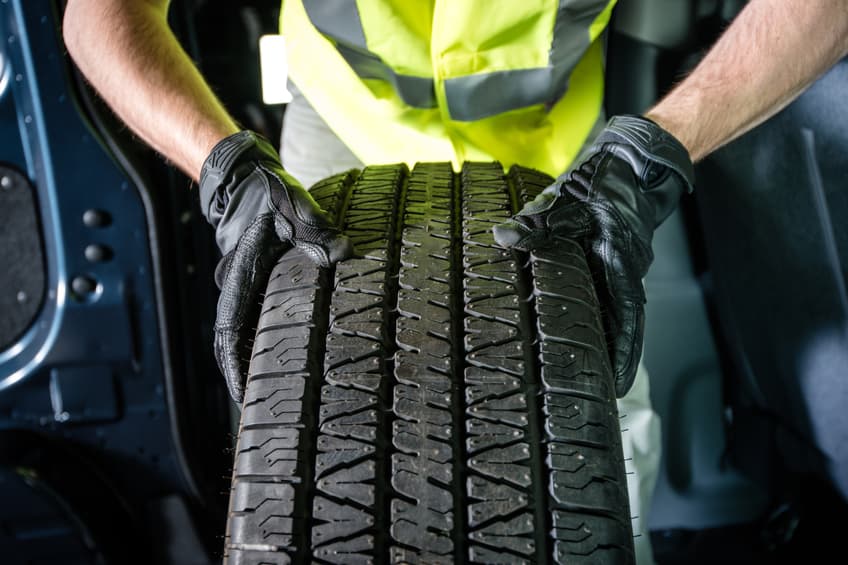
February 7, 2025
Meineke: Tire Check or Replacement
If you’re wondering when to get new tires, you’re not alone. Tires are essential for vehicle safety, fuel efficiency, and performance, yet many drivers delay tire replacement until a problem arises. Regular tire checks can prevent accidents and costly repairs.
As winter transitions into spring, February is an ideal time to inspect your tires. Seasonal temperature shifts, road conditions, and wear patterns make this month a great opportunity to determine if you need to buy new tires.
The Importance of Tire Maintenance
Tires wear out over time due to road conditions, weather, and driving habits so it's important to know when to get new tires. It's important to inspect them regularly to determine if they need to be replaced sooner. Whether you're new to owning a car or have had one for years, knowing when to replace your tires is important for safety.
Tires ensure your vehicle grips the road properly, so it's essential to watch for signs that they need replacing. Regular tire maintenance can help prevent issues and keep you safe.
When Should Tires Be Replaced and How Often?
Tires generally last between 6 to 10 years, but their lifespan can vary depending on several factors, including driving habits, road conditions, maintenance, and the type of tire. Common warning signs you need to replace your tires include: Uneven tread wear
- Uneven tread wear
- Cracks or bulges on the sidewall
- Deep cuts or punctures that cannot be repaired
- Persistent pressure loss, which signals internal damage
- Tires vibrate excessively while driving
- Reduced grip on wet or icy roads
Ignoring these warning signs can lead to dangerous driving conditions, including a blowout, a flat, or worse. Enjoy the peace of mind that comes with knowing your tires are in superb condition. At Meineke, we have the right tires for your vehicle and offer the services you need to keep your tires in good working order.
How To Check Your Tread Depth and Age
Tread depth is crucial for maintaining traction, especially in wet conditions. While the legal minimum tread depth in most places is 2/32 of an inch, experts recommend replacing tires when they reach 4/32 of an inch for optimal safety.
How to Check Tread Depth:
- Penny test: Insert a penny into the tread with Lincoln’s head facing down. If the top of his head is visible, your tread is too low, and you need to buy new tires.
- Tread depth gauge: A simple tool that gives a precise tread measurement.

Even if your tread depth looks fine, tire age matters. Manufacturers recommend replacing tires every six years, as rubber compounds degrade over time, reducing grip. If your tires are over 10 years old, replacement is strongly advised—regardless of wear.
How to Check Tire Age:
If you are unsure of the date of your last tire change, you can check the age of your tires by looking at the DOT number on the sidewall. The last four digits indicate the week and year of manufacture. For example, “3620” means the tire was made in the 36th week of 2020.
Seasonal Temperature Changes & Tire Performance
Seasonal temperature changes can have a significant impact on tire performance, as extreme heat or cold affects tire pressure, tread wear, and overall traction. In cold temperatures, tire pressure tends to drop, which can lead to reduced traction and uneven wear. High temperatures can cause tires to soften and wear out more quickly, increasing the risk of blowouts.
Timely tire replacement is vital to ensure your tires remain in optimal condition and can handle the demands of changing seasons. Regularly inspecting your tires, monitoring their pressure, and replacing them before they become too worn can help maintain safety, improve fuel efficiency, and extend the life of your vehicle.
Why February Is Right Time for Tire Replacement
Fluctuating temperatures can impact both tire pressure and wear patterns, making February an ideal time to assess your tires. In colder climates, this month marks the final stretch of winter, making it a perfect opportunity to inspect your tires before switching to all-season or summer ones. In milder regions, February offers a chance to check your tires before embarking on spring and summer road trips, ensuring they’re ready for the season ahead.
Replacing Winter Tires
If you’ve been driving on winter tires, replace them with all-season or summer tires once temperatures consistently stay above 45°F (7°C). Winter tires are designed to remain flexible in cold temperatures, which helps them grip icy or snowy roads. However, they wear out quickly in warmer weather and reduce fuel efficiency. All-season or summer tires are better suited for warmer temperatures, offering improved performance, better handling, and greater fuel efficiency. By switching tires at the right time, you can prolong tire life, improve your vehicle’s performance, and save money on fuel in the long run.
Tire Maintenance Tips for Safety & Longevity
Regular maintenance is essential for extending tire life and improving safety, fuel efficiency, and overall vehicle performance. To keep your tires in optimal condition, check tire pressure monthly, rotate your tires every 5,000–7,500 miles to ensure even wear, and align the wheels regularly to prevent uneven wear. Additionally, it’s important to visually inspect your tires for any damage, such as cuts or bulges, to catch potential issues early and avoid further complications.
Ensuring Road Safety with Proper Tire Checks
Your tires do more than just get you from point A to point B—they’re crucial for your safety and vehicle performance. Maintain them properly and replace them before they reach the end of their lifespan.
Whether you're dealing with winter wear or preparing for spring, ensure your tires are in top condition. If you notice low tread, cracks, or aging tires, don’t wait— get your tires checked by our Meineke Experts. Our certified technicians will inspect your tires, perform a tire repair, or replace them entirely.



